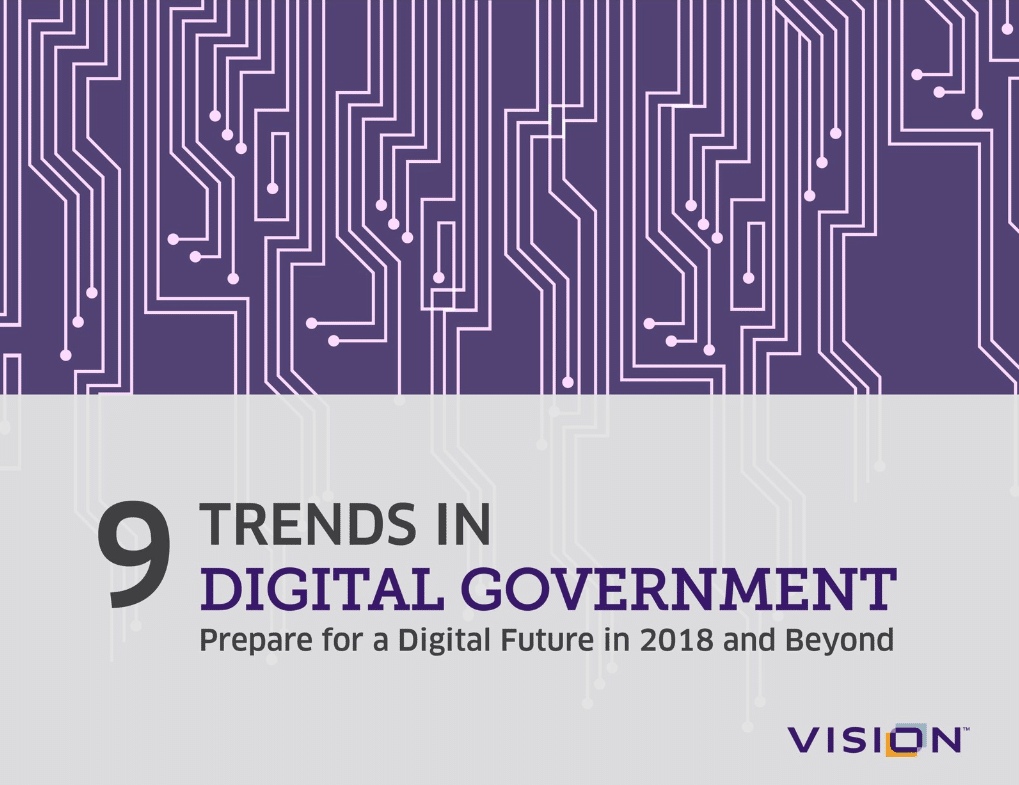The year 2018 is off to a fast start and, despite ups and downs on the Federal level, local government leaders are forging ahead and implementing technology that continues to change the relationship between citizens and their local governing bodies, new research from government website design, development and hosting firm Vision finds.
The firm’s new eBook looks ahead at the trends that will shape digital government in 2018 and offers tips to help local agencies deliver online services.
According to Accenture’s most recent Digital Pulse survey, digital government is the key to earning citizen engagement and trust. While nine in 10 citizens said they want to maintain or increase their digital interaction with local government, nearly three-quarters are not satisfied with current digital services.
David Nachman, CEO of Vision, says that 2018 will be the year that local leaders fully embrace the technologies that will help them put the “service” back in public service.
“By embracing digital government platforms and treating citizens like customers, local leaders can transform the way they deliver services to be more productive, operate more efficiently and improve the lives of their citizens,” Nachman said, in a news release. “We believe government websites will become the hub for digital engagement and the key to better customer experiences over the next five to 10 years.”
So, what are the trends that local leaders need to keep an eye on and what can they do today to prepare? In a new eBook, Nine Trends in Digital Government, Vision outlines the following trends and tips to help local leaders manage the digital transformation:
Digital customer experience gains momentum
2018 will be the tipping point of recognition for the need to create great customer (or resident) experiences. To generate support for digital customer experience initiatives, Vision recommends using data from resident surveys to gauge current wants, needs and satisfaction, and then taking steps to make sure all elected and internal stakeholders are aligned in their understanding of the meaning and importance of digital initiatives.
Personalization comes into focus
Local governments will begin their foray into personalization in 2018, allowing residents to opt in to content based on their interests and geography. Any move toward personalization must begin with a usable, search-centric website and research to uncover what visitors are looking for.
The mobile web takes on an app-like experience
In 2018, local government websites need to evolve beyond responsive design, delving deeper into the mobile customer experience. Successful mobile web design blends the best of a mobile app into a web environment for the most intuitive user experience. Vision recommends performing an audit of the most popular pages accessed via mobile devices. Then evaluate the mobile customer experience on those pages and consider creating a custom mobile view to better serve these users.
Content becomes more interactive and engaging
The trend toward more interactive content and two-way dialogue, rather than just static content published and curated by cities and counties, continues. The most successful agencies actively listen across all social channels and identify ways to extend the dialogue on important topics so community members feel heard by their government.
Content becomes more discoverable
Given the massive amount of content available on a government website, findability will continue to be a major challenge for local government entities. Everything from appropriate tagging and key words to filtering tools will help website users intuitively self-navigate to the webpage they are seeking. Search technology will become more intelligent, serving up related content based on keyword searches.
Paperless services become more common
We expect to see an increase in local government entities fully automating services on their websites as technologies like e-signatures and online payments become more cost-effective and easier to integrate with front-end web experiences. These services will require investments in new software and the patience to begin slowly until both internal and external stakeholders are comfortable with the new processes.
A team-based content model is emerging
Most local government organizations now have a distributed content model with at least one content contributor per department. Staff skills in writing for the web vary, creating a Wild West of content creation. In 2018, we will see a shift to a team-based model, with trained communications professionals at the helm, leveraging content to create a better overall customer experience.
Cloud-based hosting grows as security remains a top priority
Security is at the forefront of our minds, and it’s taking center stage when it comes to website development and hosting. As you are thinking about your website development, consider the security of your customer’s information. Your customers will only interact with your website if they trust you. Make sure your security certificate is updated on all pages and that your hosting vendor leverages a leading Distributed Denial of Service (DDoS) solution.
Web accessibility is here to stay
Government websites have often ignored users with vision loss, hearing impairments and other disabilities. Web accessibility will continue to get the attention it deserves. Not only are local government agencies recognizing that greater accessibility for web visitors is the right thing to do, it’s the law. Local agencies should appoint an accessibility coordinator and adopt a formal accessibility statement that outlines key standards and provides a contact for reporting issues.
“It’s clear that, in the local digital government arena, 2018 will be the year that more agencies move from talk into action,” Nachman concluded. “City and county websites will become more personal, mobile, interactive and engaging, creating internal efficiencies and greatly improving the customer experience.”








